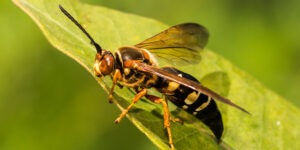Hornets: Behavior, Prevention, and Pest Control
Stinging insects like hornets can make enjoying the outdoors impossible. The sting from one of these insects is painful, and can even be dangerous for those who are allergic to the insect’s venom. Protect your home or business from hornets by learning how to deter these insects, and understanding when to call in the experts to eliminate the problem.
What Are Hornets?
Hornets belong to the wasp family. They are a type of flying insects that live and work together in a hierarchy that divides labor tasks into reproductive and non-reproductive groupings. Colonies consist of multiple generations and have a single queen while the vast majority are drones and workers. The queen starts to lay eggs when the weather begins to warm in spring.
These insects prefer to build their nest high up in trees or the rafters of the buildings. Hidden spots like underneath decks and patios, around window shutters, in playground equipment, or even below ground are also favored.
The nests are typically a gray or tan color and rounded. You may notice the combs on the inside of the nest visible from the exterior. They live in wooded areas, but populations have begun to increase in residential and business areas.
Identifying Characteristics of Hornets
Hornets are often mistaken for bees, yellowjackets, and other stinging insects, but have some distinguishing characteristics to help identify them. There are two main species found in the Carolinas:
- European Hornet: This species is closely related to another stinging insect, the yellowjacket. European hornets are the largest species of stinging insect in the Carolinas. They have long, reddish-brown or yellow-striped bodies with a paler-colored face. European hornets grow to about 1.5 inches long and have two pairs of wings and six legs. They are highly aggressive and attack if they feel threatened. This species prefers to build their nests in crevices and avoids unprotected areas.
- Bald-Faced Hornet: These hornets have long and thin bodies that are black with a white pattern on the face, thorax, and abdomen. They grow between 1/2 to 5/8 inch long.
Hornets make their nests from chewed wood pulp, which gives them a paper-like appearance.

Problems Caused by Hornets
While hornets don’t normally cause structural damage to your home or business, there is a risk of damage if they build a nest on or inside your home. They can chew through walls and siding, making their way into the interior of the building. Once inside, they could chew wires and cause electrical issues or even a fire. Nests may also draw moisture from the nectar that contributes to mold growth and structural weakness.
Hornets are usually not aggressive unless they feel threatened. They can attack in groups if you approach the nest, so it’s best to avoid getting near it. Hornet stings are painful and cause redness, swelling, and discomfort. These insects can also sting multiple times in a row. Some people are allergic and can experience anaphylactic shock, cardiac arrest, or other serious consequences. Anyone who has symptoms of an allergic reaction or severe symptoms should seek immediate medical attention.
How to Treat a Hornet Sting
If you do get stung by a hornet, care for the wound as soon as possible and stay alert for worrisome symptoms. The two biggest threats from a hornet sting are an allergic reaction or an infection. Follow these steps:
- Remove the stinger by scraping across it with a fingernail or other blunt-edged object. Don’t pull it out as this can release additional venom.
- Wash the area with soap and water.
- Apply a cold compress for 30 to 60 minutes alternating 10 minutes on and 10 minutes off.
- If stung on the arm or leg, keep the limb elevated to prevent swelling.
- Apply a corticosteroid cream or antihistamine to reduce discomfort.
- Take over-the-counter pain relievers
- Watch for serious symptoms in the hours immediately after the sting.
Symptoms of a sting include localized pain, swelling, redness, itching, and warmth. If symptoms persist or you develop signs of a life-threatening allergy like tightness in the throat or chest, problems breathing, nausea, vomiting, dizziness, sweating, coughing, or hives over a large part of the part, see a doctor for treatment.
Tips for Hornet Control and Prevention
The first thing to do if you want to keep hornets away is to seal any cracks, holes, or gaps around your property. Many hornets prefer to build nests in enclosed spaces, so these openings invite the insects in.
Other preventative measures include removing food sources and standing water. Pick up fallen fruit from trees, clear away food residue and wipe down surfaces, and keep trash sealed in bins. Empty out birdbaths, clear water away from patio furniture, and fill in low spots in the grass that hold water. Planting mint around your property can also deter hornets.
How to Get Rid of Hornets
If you notice several hornets flying around, you likely have a nest nearby. Conducting regular checks of your property can help you spot nests. Use caution when buying products available at your local store to kill hornets. They are sometimes dangerous and often ineffective for hornet control.
Attempting DIY methods to eliminate hornets can result in injury. Don’t put yourself at risk. Instead, give the experts a call to get fast, safe, and effective results. Killingsworth Environmental provides quality, state-of-the-art pest management services for hornets in the Carolinas.
When to Call a Hornet Exterminator
Don’t risk your health by attempting to remove a hornet nest on your own. Leave that job to the experts who have the training, skills, and equipment to get the job done safely. At Killingsworth Environmental, our team knows how to identify pests and conducts a thorough inspection of your property to learn the scope of the problem and create a customized plan to eliminate the hornets and discourage them from coming back. Contact us today to learn more and request your free estimate for exceptional pest control in the Greater Charlotte Area.
GET A FAST FREE ESTIMATE
QUICK LINKS

